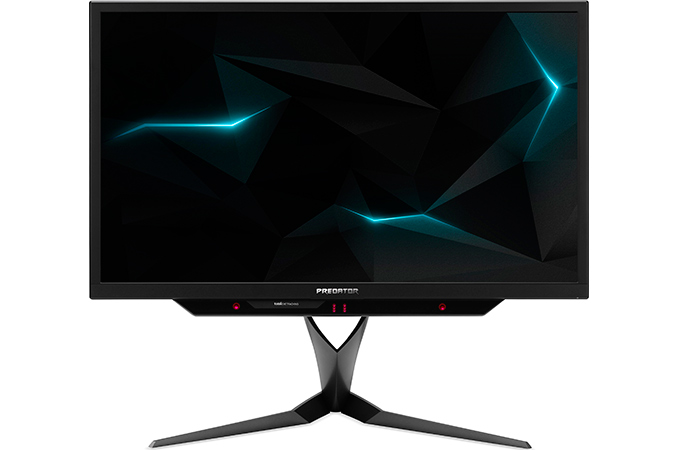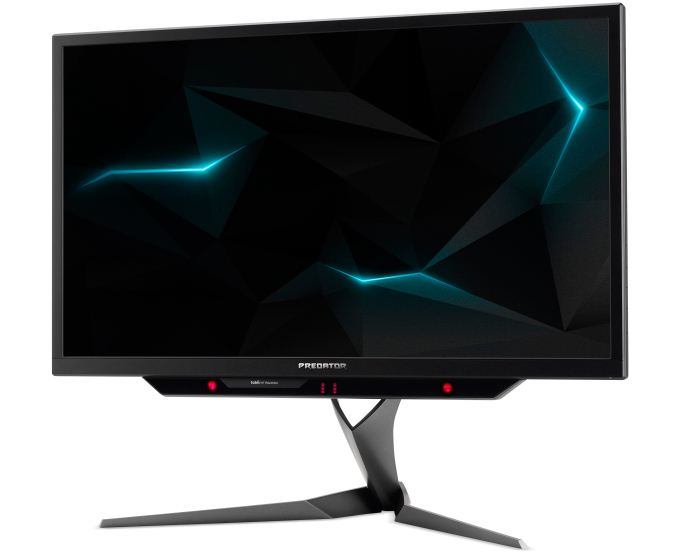Acer Announces Predator X27 Monitor: 4K@144 Hz with DCI-P3, HDR10, & G-Sync
by Anton Shilov on April 27, 2017 9:00 PM EST- Posted in
- Monitors
- Acer
- IPS
- 4K
- Quantum Dot
- AHVA
- DCI-P3
- HDR
- Predator X27

At its annual Next@Acer event, Acer formally introduced the Predator X27, its new flagship gaming display. The company's first HDR monitor, the Predator X27 is Acer's implementation of NVIDIA's prototype HDR monitor design, which we first saw back at CES 2017. So like NVIDIA's prototype, Acer is aiming for the top with this monitor, offering 4K, HDR, a wide color gamut, and a high refresh rate all in a single display. Unfortunately for those of you eager to shell out for the Rolls-Royce of gaming monitors, you'll have to wait a bit longer; Acer is not announcing a release date or a price at this time.
By the numbers, the Predator X27 offers a 4K resolution, a 144 Hz refresh rate, a 1000-nits brightness, and uses a quantum dot film to enable HDR10 and the DCI-P3 color gamut. To further appeal to gamers, the Predator X27 also supports NVIDIA’s G-Sync HDR technology as well as Tobii eye-tracking. The new unit is one of a few announced 4K displays to support such a high refresh rate along with HDR10 and NVIDIA’s G-Sync HDR technology.
The Acer Predator X27 is based on AU Optronics’ M270QAN02.2 AHVA panel with a 3840×2160 resolution, 178°/178° horizontal/vertical viewing angles, up to 1,000 nits brightness, a 4 ms response time and a 144 Hz refresh rate. The monitor comes with a direct LED backlighting system with 384 zones, which ensures both high brightness as well as better contrast ratios through localized dimming. The backlighting system is further enhanced with a quantum dot film in order to give the monitor wide color gamut capabilities, allowing it to display 96% of the DCI-P3 color gamut, which pairs up nicely with its HDR support via the HDR10 format. Finally, the Predator X27 features NVIDIA's G-Sync HDR variable refresh rate technology.
To take full advantage of the Predator X27 monitor, gamers are going to need an NVIDIA GeForce GTX 10-series graphics card with a DisplayPort 1.4 connector. NVIDIA & Acer are using every bit of bandwidth offered by DisplayPort 1.4 here, and even that's not enough; the X27's bandwidth requirements actually exceed what DisplayPort can provide. As a result the monitor (like all monitors based on the NVIDIA design) will use 4:2:2 chroma subsampling when gaming to stay within the bandwidth confines of DisplayPort 1.4. Meanwhile as you might expect, the display's lone HDMI 2.0 port is limited to 60Hz operation. In addition, expect the display to require a USB cable to control the Tobii eye-tracking hardware.
To date, only Acer and ASUS have announced gaming displays powered by the M270QAN02.2 AHVA panel from AUO and supporting 4Kp144 with a 1,000 nits brightness, quantum dots, and HDR10. Such monitors in many ways represent a new generation of gaming displays that support not only a high resolution and refresh rate, but also the DCI-P3 color saturation, advanced backlighting with local dimming, and so on.
| Specifications of Acer 4K/144Hz G-SYNC Gaming Monitor | |||
| Predator X27 | |||
| Panel | 27" IPS (AHVA) | ||
| Resolution | 3840 × 2160 | ||
| Refresh Rate | 144 Hz (w/4:2:2 Choma Subsampling) | ||
| Variable Refresh Rate | NVIDIA G-Sync HDR | ||
| Response Time | 4 ms | ||
| Brightness | 1000 cd/m² | ||
| Contrast | Unknown | ||
| Backlighting | Direct LED, 384 zones | ||
| Quantum Dot | Yes | ||
| HDR | HDR10 Support | ||
| Viewing Angles | 178°/178° horizontal/vertical | ||
| PPI | 163 pixels per inch | ||
| Colors | 1.07 billion | ||
| Color Saturation | sRGB: 100% Adobe RGB: 99% DCI-P3: 96% Rec. 2020: 82% |
||
| Inputs | 2 × DisplayPort 1.4 1 × HDMI 2.0 |
||
Acer remained tight-lipped about pricing and availability timeframe of its Predator X27 display, but since AU Optronics is reportedly kicking off mass production of its M270QAN02.2 in July, it is likely that Acer, ASUS and other companies that use the panel may start selling their products on its base in late Q3, or early Q4 2017. As for pricing, we may well be talking about devices with MSRPs north from $1500 (some whispers say so), but Acer and its rivals yet have to announce their MSRPs.
Related Reading:
Source: Acer
















30 Comments
View All Comments
Frenetic Pony - Thursday, April 27, 2017 - link
Yeeee- "G-sync" I WILL CHOKE THE LIFE OUT OF YOU YOU STUPID SHORTSIGHTED MOTHERFU- stop buying into Nvidia's pay to play monopolistic bullshit. Stop, just, STOP.vladx - Friday, April 28, 2017 - link
I have no problem buying G-Sync, it's not like FreeSync works with Nvidia who have the best GPUs. So I'll probably only be buying G-Sync monitors for the next 10 years at least.BurntMyBacon - Friday, April 28, 2017 - link
If (and only if) the industry pushes full bore into Display Port Adaptive Sync (DP A-Sync or FreeSync if you want to use AMD's branding), you can be sure nVidia will make sure their cards support it. They already have the necessary hardware capability. Also, how often do you switch monitors? I have monitors that I still use from more than 10 years ago.1) With Intel committing to DP A-Sync and no ability of any manufacturer not nVidia to use G-Sync, there is no realistic scenario where DP A-Sync goes away.
2) DP A-Sync and G-Sync could both continue in perpetuum. Though, monitor manufacturers probably wouldn't prefer this long term as you can't use the same scaler to support both standards. They'd rather spend the resources on one design than incur the cost of designing two monitors to address the "Sync" market. The required scaler for G-Sync is also limited where scalers from other manufactures provide more input flexibility. Manufacturers like ability to choose between different scalers with different options for different price points. Furthermore, nVidia is the only manufacturer of the required scaler for G-Sync Monitors. Most manufacturers don't like to be on the receiving end of sole source situations as there is nowhere to go if the prices are untenable and there is no workaround when there are supply issues. There are also a whole lot of well established scaler manufacturers that don't appreciate being pushed out of an area of the market due to nVidia's dominance in GPUs. I doubt it'll ever get there, but if things go particularly bad (Everyone buys nVidia and wants G-Sync) you could see some lawsuits here.
3) DP A-Sync could win. nVidia will fight this long and hard, but if ATi gets competitive in the high end again (consistent execution) and Intel makes good on DP A-Sync support it may eventually be possible. At such a point, nVidia will simply enable DP A-Sync on their desktop cards under their own branding (G-Sync 2, Open G-Sync, etc.) while maintaining legacy GPU support. They would lose very little in the way of GPU sales at this point. Their GPU customers would lose very little at this point either. The only potential losers in this scenario are G-Sync monitor customers who are still locked in to nothing but nVidia cards as long as they want to use the monitor with "Sync".
r3loaded - Friday, April 28, 2017 - link
Almost perfect, just needs FreeSync 2 instead of proprietary sync.edzieba - Friday, April 28, 2017 - link
Ooh, very close to perfect. If a 32" version meeting the same specifications is released I'd jump right on it. I couldn't go back down to 27" after using a 34" ultrawide.Major_Kusanagi - Friday, April 28, 2017 - link
Agreed. I've got a 43" 4K Wasabi Mango (UHD430) and I don't think that I'd be able to go smaller than 32" for a 4K monitor.Vatharian - Friday, April 28, 2017 - link
Here it is. It came. The holy grail of gaming. The one and only, perfect monitor. If only I could wait... I bought PG348Q couple months ago... but this may be enough to get me to sell it.usernametaken76 - Saturday, April 29, 2017 - link
Price will likely be $1399.usernametaken76 - Saturday, April 29, 2017 - link
Or $1999.